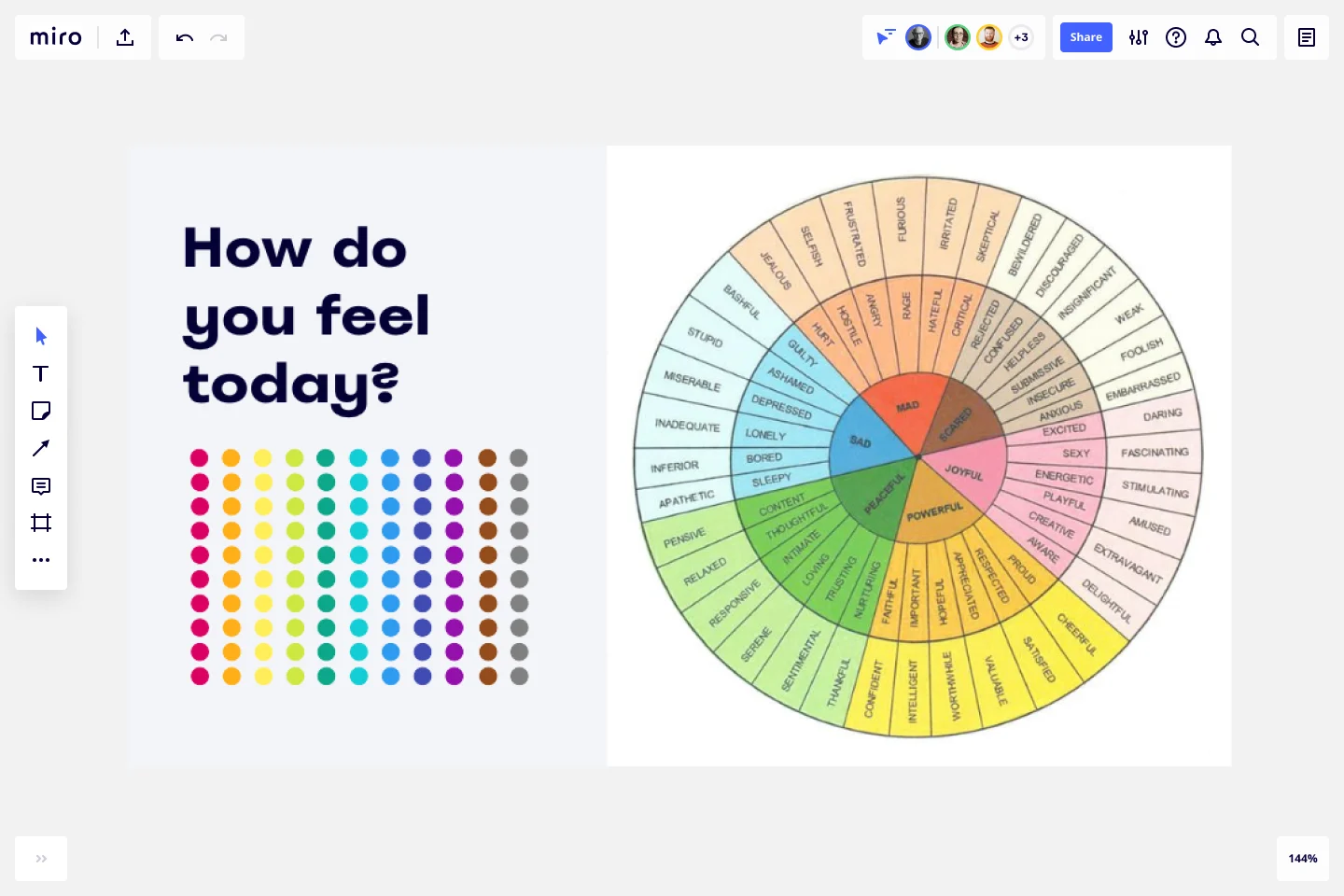The Emotions Wheel Icebreaker Template
Allow people to express emotions and connect with each other. Use the Emotions Wheel Icebreaker to build the foundations for an important conversation.
About the Emotions Wheel Template
Ana Dvonirkova, Learning Design Program Lead at Miro, created The Emotions Wheel Template. It was primarily created to help connect teams while working remotely and has also become a great tool for reconnecting hybrid teams. In Miro, Ana uses this icebreaker at the beginning of All-hands meetings, but over time this template has proven to be a great human check-in for every virtual and in-person meeting.
What’s the Emotions Wheel?
Psychologist Robert Plutchik developed a wheel of emotions to illustrate various feelings. In its original version, it shows eight core human emotions, opposite to each other, and how they develop into other emotional states that could be more intense or milder.
This tool helps us see what’s causing us to have a specific feeling and better identify and understand how we feel. Over time, many variations of the emotions wheel were developed and created, and the one used in our template shows six core emotions and the emotional states they can develop into.
Benefits of using the Emotions Wheel Template
When leading an important meeting or workshop, the Emotions Wheel Template helps you build empathy amongst participants and do a quick check-in to see how your audience is feeling and the energy levels at that moment.
It’s also a way to be inclusive and validate different feelings and experiences, acknowledging that not everyone in the room might be feeling the same way.
This template is also an excellent tool to connect teams and people, allowing different teams and audiences to express themselves and feel seen by others in the meeting.
How to use the Emotions Wheel Template
Add the Emotions Wheel Template to your board when leading a meeting or workshop. This template doesn’t need to be edited and doesn’t demand much knowledge from your participants using Miro.
After everyone joined your meeting, ask them to grab a dot and place it on a section of the Emotions Wheel, one that represents their current emotional state.
If you want to give participants more privacy while adding their dots, you can instruct them to turn off cursors, and at the moment of the icebreaker, stop sharing your screen so everyone can privately add their dot to the wheel.
After everyone added their dots, analyze the emotions, and highlight the ones marked most. End this emotions wheel exercise by saying that every emotion is valid and perfectly normal, and thank everyone for participating and being honest.
If you feel the group has enough openness, ask for volunteers to share their answers and experiences.
How many emotions are on the emotions wheel?
Miro’s Emotion Wheel Icebreaker Template contains an emotion wheel with six core emotions, each leading to twelve different emotional states. The original emotions wheel created by Robert P. had eight core emotions, and each emotion would result in two other emotional states.
Can you use the emotion wheel in the classroom?
Many educators and teachers use the emotion wheel as a teaching resource in the classroom. It helps students to connect to their emotions and to identify and communicate their feelings in a more accurate way. The emotion wheel can also help teachers create an inclusive learning space where students feel seen and heard.
Get started with this template right now.
Workshop Icebreaker Collection Template
Works best for:
Icebreakers, Workshops
Use this Workshop Icebreaker Collection Template to bring energy, engage people, and foster collaboration when running a meeting or workshop.
4Ps Retrospective
The 4Ps Retrospective template offers a structured framework for teams to reflect on past iterations or projects using the 4Ps model (Praise, Problems, Possibilities, and Plans). It provides elements for sharing positive feedback, identifying challenges, exploring opportunities, and setting action plans. This template enables teams to conduct retrospectives systematically, generate actionable insights, and drive continuous improvement. By promoting a balanced and comprehensive approach, the 4Ps Retrospective empowers teams to enhance collaboration, boost morale, and achieve their objectives effectively.
Taco Tuesday Retrospective
Works best for:
Agile Methodology, Retrospectives, Meetings
The Taco Tuesday Retrospective template offers a fun and informal approach to retrospectives, perfect for fostering team camaraderie. It provides elements for reflecting on past iterations over a casual taco-themed gathering. This template enables teams to relax, share insights, and brainstorm ideas in a laid-back atmosphere. By promoting social interaction and creativity, the Taco Tuesday Retrospective empowers teams to strengthen relationships, boost morale, and drive continuous improvement effectively.
Kudos Template
Works best for:
Team management
The Kudos Template boosts team morale by providing a structured platform for team members to recognize and celebrate achievements. It fosters a positive environment of appreciation, respect, and unity.
Business Model Canvas Template
Works best for:
Leadership, Agile Methodology, Strategic Planning
Your business model: Nothing is more fundamental to who you are, what you create and sell, or ultimately whether or not you succeed. Using nine key building blocks (representing nine core business elements), a BMC gives you a highly usable strategic tool to develop and display your business model. What makes this template great for your team? It’s quick and easy to use, it keeps your value proposition front and center, and it creates a space to inspire ideation.
Soccer Retrospective
Works best for:
Agile Methodology, Retrospectives, Meetings
The Soccer Retrospective template offers a sports-themed approach to retrospectives, using the game of soccer as a metaphor for teamwork and strategy. It provides elements for reflecting on past performances, analyzing strengths and weaknesses, and setting goals for improvement. This template fosters a competitive yet collaborative spirit, encouraging team members to work together towards common objectives. By leveraging the metaphor of soccer, the Soccer Retrospective empowers teams to refine their tactics, enhance communication, and achieve their goals effectively.
